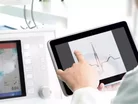Tele-Medicine: More Than Community Care

Written by Holger Felgner, General Manager at TeamViewer
As the NHS focuses more heavily on community-based care, tele-medicine is taking centre stage. Effective use of tools to enable patient conditions, such as diabetes, to be remotely monitored will be key to enabling more patients to be treated at home and support the community-based care model. As Holger Felgner, General Manager at TeamViewer explains, the role of remote access software in delivering high quality care, irrespective of location, will become increasingly important. This is a real chance for clinicians to both collaborate and remotely deliver truly innovative patient services.
Realising Efficiencies
In the wake of the report into the failures at Stafford Hospital, decision makers across the NHS are immersed in debates about the most cost-effective and efficient way to structure an overburdened health care service without compromising the quality of care. Facing year on year requirements to cut costs, it is becoming increasingly important to streamline processes, reduce duplication of effort and, where possible, improve collaboration between cross-discipline teams.
Clinicians within hospitals need a better way to share knowledge and expertise irrespective of geographical location; they need to be able to deliver remote advice and services to patients at home; and they need to create a secure, effective way of working with the growing numbers of private care providers to ensure consistency of care.
Given these pressures, it is no surprise that a number of tele-care models and ideas are being evaluated across the NHS today. Many, however, are focused on patient control – asking the patient to upload information such as insulin readings or blood pressure results into a portal. Not only are these developments time consuming, they also place the onus on the patient to update information.
Furthermore, this approach does not support the multi-discipline, multi-location collaboration model that will be essential to cost effectively maximise expertise, minimise costs and improve patient care. A growing number of institutions achieve this model via remote access software. The technology can be immediately deployed both in the hospital environment and patient home with no fuss or IT overhead and allows connecting to a remote computing system within seconds.
Proven Model
Indeed, there are many examples today that demonstrate the way tele-care enables secure collaboration between clinicians irrespective of location.
For example, a doctor in one hospital may take an x-ray of a broken bone. Though he has dealt with many similar injuries, this specific case is something he has never seen before. However, he does know someone in another hospital that could help. On the basis that the x-ray is a high-resolution image, rather than reduce the file size and email the photo to his colleague, the other doctor can remotely access his computer and view the x-ray in high resolution. At no point is the patient’s data transferred between clinicians: the advising clinician is securely accessing data held at the hospital, avoiding any risk of breach in patient confidentiality.
In addition, tele-medicine has a role to play in reducing out-patient appointments, which is a key consideration for those with chronic conditions or disabilities. For example, in Israel, a company called MediTouch that manufactures innovative, wearable motion capture devices for rehabilitation, uses remote access software to assist patients in different countries. The patient’s aid sets up the physical device between the patient and the computer while the doctor accesses their computer and controls all functions for the rehab process. Taking this approach not only minimises the complicated and costly process of getting the patient to a hospital for rehab but also avoids the alternative of having multiple clinicians spending time travelling between patients, enabling a single clinician to efficiently and effectively support multiple patients from a single location.
The potential benefits within the hospital environment are significant. Specialists can provide care from a distant location, minimising overtime payments and improving the speed to response to a patient. Hospital rounds can be transformed by replacing the traditional patient chart on a clipboard system that still dominates the ward round with remote access enabled tablets. Instead of having a nurse prepare all the necessary documents which the doctor then carries, makes notes on and then asks a nurse or intern to update the system, the doctor could simply carry a tablet. From the tablet, the doctor can connect to the system on this PC, get all data for the patient on screen and make the necessary changes. In other words, it is only one person doing the work, and there is no need to buy, print and then throw away an enormous amount of patient charts.
Collaborative Synergy
The key to facilitating this collaboration is secure remote access technology that allows individuals to share their screen or access a database, use the web cam to check physical symptoms and share analyses with colleagues. Critically, there is no data transfer, reinforcing security and avoiding the risk of patient records becoming dispersed across multiple locations. Combined with a full audit trail – including recording of clinician conversations if required – the hospital can ensure every patient related interaction and discussion is recorded.
Given the massive changes currently underway across the NHS, it is essential to grasp every opportunity to reduce costs through collaboration whilst also improving patient care. The key to good patient care is speed and relevance of communication: and that must be the key for tele-care. Successful deployments can provide the real-time collaboration required to cut down on wasted travel time, excessive paperwork and extended overtime payments. Critically, patients will also receive a faster, more relevant response and better service.
Without a doubt, tele-medicine can transform lives. The challenge will be to ensure that tele-medicine is not perceived solely as a way of monitoring patients at home but a real chance for clinicians to both collaborate and remotely deliver truly innovative patient services.



